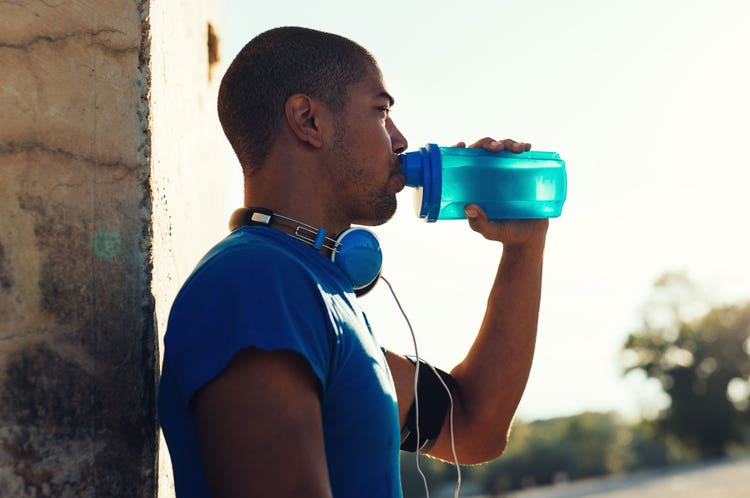How Much Should You Drink During Your Workout?

Spoiler alert: you don’t have to give up coffee. But skip sipping a drink before a workout and you could peter out prematurely. Glug too much and your stomach may pay the price. That’s why you need to know the hydration rules. “Muscles perform better when well-hydrated,” says Chicago-area sports dietitian Linda Samuels, MS, RD, CSSD and the nutrition coach for the Triathlon Team at Northwestern University. Here are experts’ answers to your top questions and three ways you can check for dehydration.
- Should I chug water before a workout even if I don’t feel thirsty?
Samuels’ number one rule: hydrate up all day long—not just before a workout. To stay properly hydrated, you only need to drink to thirst, explains Sandra Fowkes Godek, PhD, HEAT Institute Director at West Chester University. “Your body knows how to keep you in balance, and it tells you with your thirst mechanism,” she says. Drinking more than you need won’t give you an edge. So if you’re thirsty before a workout, sip until you’re quenched—don’t force yourself to guzzle the entire bottle. - Is it possible to drink too much?
Yep—it’s called water intoxication. This dangerous condition is more common among pro marathon runners than the average exerciser, but can happen if you’re exercising intensely for long periods outdoors, losing a lot of sodium through sweat, and drinking too much water. Just remember what we said above about not forcing yourself to chug water if you’re not thirsty and you should be good. Because even if it doesn’t make you sick, it can decrease your ability to perform well if your stomach is sloshing around with liquids, says Godek. - I love the jolt I get from coffee, but I’ve heard it’s dehydrating. Should I skip it?
Not if you like it and know your body can handle it. “What we’ve recently seen in sports science studies is that caffeine is really not dehydrating like we used to think,” says Samuels. Better yet, studies show it can actually make your workout feel easier and help you recover faster. Plus, you probably don’t need as much as you think for the boost, she says. Everyone responds to caffeine differently, but as little as 5-20 mg per 10 pounds of body weight can do the trick (75-300 mg for a 150-pound woman; one 8-oz cup of coffee typically packs between 100-200 mg). Just try to stick to the same amount every day, since research shows your body adjusts to a steady caffeine habit, which helps stave off dehydration—but drinking a bunch one day and none the next can throw that balance out of whack. - Should I drink fortified water or plain H20?
Plain H20 is fine for most workouts, says Godek. You don’t need to shell out on special electrolyte-, vitamin- or antioxidant-enhanced water, especially for short durations. However, if you’re doing high-intensity exercise for more than an hour, the American Council on Exercise recommends drinking a sports drink for a quickly digested carbohydrate fix that can help keep you going. - If it’s a hot, humid day, how much more should I drink?
The amount different people sweat varies widely, so there’s no hard and fast rule on exactly how much to sip. Remember that “drink when you’re thirsty” rule mentioned a few times already? It applies here, too, says Godek. “There’s no question you should be drinking more, but follow your thirst mechanism for when and how much to drink,” she says. Translation: listen to your body.
HOW TO KNOW IF YOU’RE HYDRATED ENOUGH
Here are three self-tests for assessing your hydration status:
Urine color: It should look light yellow. “Think lemonade, not apple juice,” says Samuels.
Skin snap: Pinch a small section of skin on the top of your hand. If it snaps back to normal quickly, you’re hydrated. It if goes back slowly, you may be dehydrated.
The scale: Called the sweat rate test, here’s how to do it: weigh yourself before and after exercise. The difference will give you the number of fluid ounces you should drink during exercise to replenish losses in those particular conditions (such as hot and humid, or indoors and comfortable).